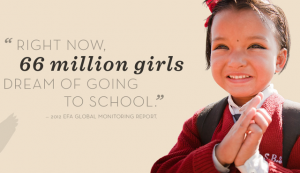‘girl rising’: empowering girls through education
In most contemporary western countries, there is little difference between the educational participation of males and females. While in the past it was males that predominantly participated in the education system and the workforce, while females worked within the private realm of their home; changes in legislations and cultural values have over time made the picture more equal. In Australia, boys and girls are both educated through school; and women’s participation in the tertiary education system has in fact taken over men’s.
However, while equal opportunities in education have been provided to males and females in Australia, this is unfortunately not the case across the world. Globally, there are still many children not in school; and because of the existence of gender inequality, these children are predominantly girls.
The statistics are disheartening. We tend to think of males and females now being equal, but around the world there are over ‘66 million girls currently out of school’. Around the world, millions of girls face barriers to education. Lack of access is highly prevalent in the developing world.
This is largely because in poorer countries, families consider working at every possibility to be beneficial. According to World Vision, girls are seen as able to contribute to labour; and thus, educating girls is seen as an unnecessary expense. In these countries, the education system is usually reserved for boys, while girls stay home and support their family by doing household chores. Although some girls enter school for their early years, they usually drop out once they are able to work.
This is sad in itself, but what is even worse is that this perpetuates the cycle of poverty. According to the World Bank, a girl with an extra year of education can earn an extra 20% as an adult. The more education a girl has, the more likely she able to get and maintain a job as an adult, and in turn, support her family and keep them out of poverty.
In addition to this, statistics suggest that girls with an education have better health outcomes and less illness within their family. This is largely because a girl with an education is more likely to avoid an early marriage and is likely to have children later. In developing countries, girls are often married young for financial sustainability. Once their families can no longer afford to keep them, they pass them onto a wealthier man, who they know can economically look after them. This pattern is highly prevalent; but evidence suggests it can be avoided. Girls who receive an education are considerably less likely to go down this path. They are much more likely to marry later, and have children at an older age, when it is physiologically safer.
While this article only provides a snippet of the story, the film ‘Girl Rising’ showcases the real stories of 9 women, and how they have been empowered through gaining an education. In 2013, World Vision has released this film in collaboration with 10×10. It will be premiered in cinemas across the country on October 11. Go here to find a screening near you.


